A really nice thing you can cast is larger stepping stones using rubber doormats in a mold. I got hold of two different rubber mats with different sizes. I made one mold for each mat and used a steel mesh to reinforced the concrete because it is so big.
When casting, I filled one layer with concrete in the mold, then I put the steel mesh in and one more layer of concrete. I patted down the rubber mat up side down.
Then, I left it to harden for two days before I took apart the mold and removed the rubber mat. To get a nicer finish I used a rotating wire brush to get rid of the casting flash.
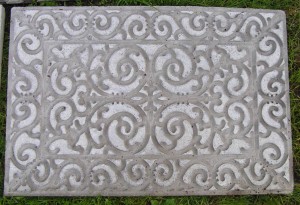
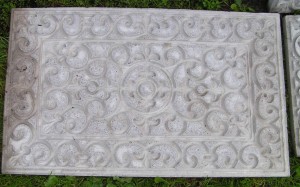
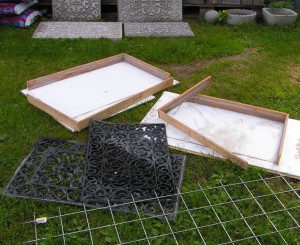
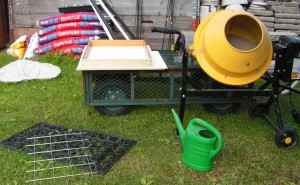
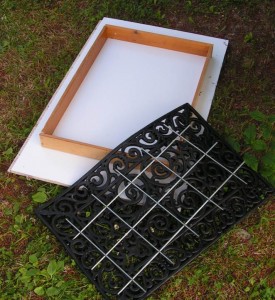

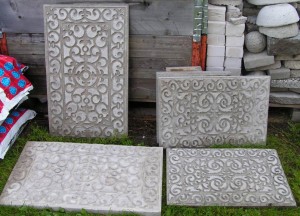
I LOVE these!! I’d love to put down slate to create a 10′ x 12′ patio from my front porch to the driveway but those are so expensive but these are much more beautiful than the slate ever would be! Will also have to go look at concrete tints before I decide if I want to tint the concrete or leave it natural.
Question please: If after leaving the rubber mat in the mold for 2 days, are able to reuse it for more “stones” after you pull it out because I’d need multiples. And by “casting flash” do you mean your use the wire brush to get rid of the “crispness/distinct edges” left by the mat in the concrete to make the imprint have a little more softer edge?
Hi Lori, Yes the rubber mat can be reused several times.
The edges can be quite distinct and I use the wire brush to soften them. I use a rotating wire brush in the drilling machine because it is easier and much faster. Keep in mind that it is quite dusty so use eye protection and a dust mask.
Doesn’t the rubber mat tear up when you pull it off the dried cement? These are just lovely!
If you do not pat it down too deeply into the concrete, it’s no problem to pull the rubber mat gently of. The back of the mat must always be visible. It must not be below the concrete.
Hello, you really have a super idea here. I have a few questions for you. How do you make the rectangle mold? And what materials do you use? Can you spray anything on the mat like WD-40 to keep it from sticking? How many sacks of concrete per mold? Thank you.
Hi Danielle, I can’t take credit for this idea. Some years ago I read in a Swedish garden forum and saw this idea. I immediately felt that I had to try this and was delighted with the result. 🙂
I used junk pieces that were left over from our house renovation to make my molds. You need a base plate and four bars. The bars should be wide enough to hold at least 2 inches of concrete plus the rubber mat. Cut the bars and screw them together to make a frame. The frame should be slightly larger than the rubber mat. Screw the frame down the bottom plate. Now the mold is ready.
You can use WD-40, silicone spray or cooking oil on the rubber mat to prevent the concrete from sticking.
You need about 13 liters of ready-mix concrete for the smaller mat and 18 liters for the bigger if you make them 2 inches thick.
Can these be cast with hypertufa ?
I don’t think hypertufa is strong enough for this.
Would you consider making a video of making one of these and putting it up on youtube or some other social networking site like facebook.
I’m sorry but I will not make a video of this. I’m not planning to make any more of these because I have not figured out what to do with the four ones I already have. 🙂
However, I have saved the rubber mats and the mold if I would like to make more of these in the future.
That was going to be MY question…. were the rubber mats ruined when they were removed. I’m a novice, so this may sound silly, but did you have to put anything on the mats before pressing them in, to ensure they came off in one piece? ***Never mind… I kept reading & found my answer. 🙂
These are really beautiful. Thank you so much for the excellent instructions, it is very generous of you.
What do you lay the wood frame on?
I just use scraps from when we put in new ceiling in the house. It’s only foiled chipboard but you can use whatever you have.
Are the mats uncomfortable to walk on barefoot? I would love to make a path with this design but my family enjoys to go barefoot. Thanks for posting! Great instructions!
If you grind the top carefully so there are no sharp edges, you can walk barefoot on them without problems. I also like to walk barefoot and have no problem to walk on mine.
This is so neat..What did you use on the bottom of your mold (the white part)
it’s foiled chipboard and it’s just leftovers from when we put in new ceiling in the house. 🙂
Question Monica, I see your finished pavers are 2 colors: The background or indented design is white and the raised part of the design looks to be the natural concrete color. How did you paint these? Before you removed the rubber mat? And what kind of paint did you use?
I have not painted them at all. The only thing I did was grinding the top surface with a rotating wire brush to make them smoother to walk on.
What is the metal bars on top of the rubber mat for?
The steel mesh is to reinforce the concrete. The finished stepping stone is quite big and without the steel mesh the risk of it to crack is bigger when walking on it.
Hi Monica!
I found a link to this project on Pinterest and I adore the idea of making a concrete doormat. I have never done anything concrete related but I just moved and I am looking to do some creative things around my new space. This project inspired an idea.. and I have no clue whether it will work so I am open to any ideas, suggestions, advice, etc.
I have a dog who constantly tracks dirt indoors and I have been considering purchasing one of those artificial grass door mats to catch the dirt on his paws before he comes inside (the one I found to purchase is on amazon: http://a.co/ehlnnVw ). After looking at your post I thought it might be interesting to create a grass door mat with a basic concrete diamond outline pattern (similar to the patterns found on large driveways, and here: https://s-media-cache-ak0.pinimg.com/originals/e3/9a/f5/e39af540ef96740dcc6d5dc38a6cfc5c.jpg ). Would that be at all possible to do? If yes, any tips and suggestions on the easiest way for a first timer to create this are very much appreciated!
Hi Meghan, I think it’s possible to make a door mat with a diamond pattern as you showed in the links, but then you have to build a mold by hand so the finished concrete will have cavities in the pattern you want and just as deep as the grass mat. Then you cut out and glue the grass mat in the cavities.
I love this idea, and intend on using it as a surround for a client’s Koi pond. We’re going to take it a step further, and float a slab across the pond as a bridge, continuing the pattern. I intend on staining (antiquing) the pavers using non toxic, black acrylic paint. Should be pretty classy
will you please send pictures of your end result…….thank you
Hi Monica, these look amazing! I’m considering making them for a walkway in my yard. Have you had any problems from water settling into the grooves of the design after it rains?
There will always be some water in the grooves after rain but I have not had any problem with this. It dries up quite fast.
If you’re worried about water damage, seal the finished pavers with concrete sealer. You’ll need to treat every two years. Also, make sure the pavers are setting on a level bed of sand to keep them from cracking under pressure
Hi Monica,
I wonder if you could fill in the design with a different colored sand or mortar the way you would fill in the gaps of a patio paver? That way you could end up with a flat surface, but keep your design.
Hey there, how did you secure your mold frame? Do you use screws? Do you oil the frame? Thanks
For the mold frame I used some left over scrap material. I screwed the frame together and then screwed it to the base plate. I did not use any oil and I did not have any problem to unmold it.
I think you could use hypertufa if you were making these for an upright use like a wall decoration. I’m going to try it on my mobile home skirting area as I hate the lack of choice for that area!
Great idea.. I’m going to do the same.. Did you make any?. If so how did it work out?
What kind of concrete did you use to make your stepping stones? Did you use a smooth mortar mix without stones, or a regular concrete mix that has stones in it for an aggregate?
I used a fine concrete mix (0-6 millimeter grain size). If you use a mix without stones I think you will lose durability.